How to Decorate with Floating Bookshelves
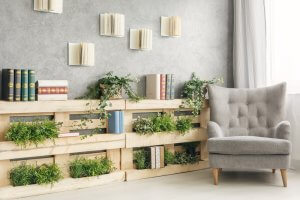
In this article, we want to give you a step-by-step guide to decorating with floating bookshelves. Simple, quick and low-cost, you’ll have your shelves up in no time.
Most modern houses come with one huge downside – a lack of storage. So it’s important to try to make the most of every last inch of space, without your home looking cluttered.
When it comes to creating additional storage, floating shelves are a great option, as they don’t take up as much room as an ordinary bookshelf. Plus, you can place them at any height, so they’re a great way to make good use of empty wall space above low furniture, such as coffee tables and television stands.
While many stores will only offer the standard flat, rectangular shelf, there are a number of other options to choose from. You’ll also need to think about aspects such as thickness and color, as they will have a huge impact on the overall look.
In this next section, we’ll give you some ideas and advice for decorating with floating bookshelves. You’ll soon see just how practical and useful these shelves can be.
Create your own floating bookshelves – what you’ll need
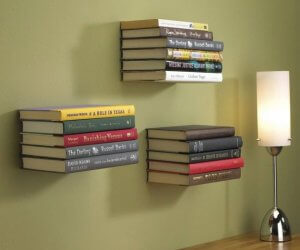
The first step is to choose the material for your shelves. You’ll find a variety of wooden, glass and plastic (methacrylate or melamine) shelves in most home stores. For example, IKEA has a good range of shelves on offer.
If you decide to go for wooden shelves, you have the option of making them yourself, using pieces of scrap wood you have at home. It’s simply a question of attaching them together until you have the desired thickness.
If you do choose to buy them from a store, you’ll need to think about the style you want. For example, you can find shelves with square, round or beveled edges.
The only downside to buying your shelves in-store is that you may find you’re slightly limited in terms of the sizes and thicknesses on offer. However, if you’re into DIY, you could always customize your shelves at home.
Next, you’ll need to buy shelf brackets. You should be able to find these in most hardware and DIY stores. These are usually fairly cheap, and come in a range of different sizes and weight capacities, so it’s best to think about how much weight you want your shelves to support before you buy.
Finally, all you need to do is install them. Use a drill to make holes in both the shelf and your wall. If you don’t want to make holes in your wall, we recommend choosing hanging shelves instead. These will help you make the most of your space, without damaging your walls.
How to decorate with floating bookshelves
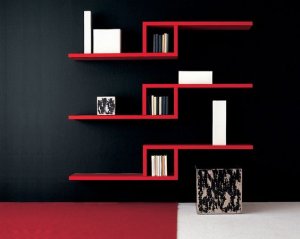
As we mentioned at the beginning of this article, there are so many ways you can decorate with floating shelves. They come in a range of materials and designs, each of which will help you create a different look.
The standard shelf
The standard rectangular shelf is the simplest and most popular. Some people prefer to have a single, long shelf running along one wall, often placing it parallel to the TV stand.
Other people like to have two or three shelves, placing them one above the other like a normal bookshelf. Because they are smaller, it’s important not to overload them, as exceeding the weight capacity could cause them to fall down.
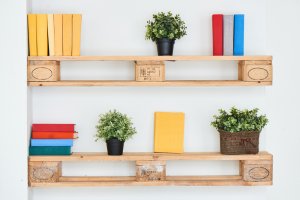
Another option is to arrange your shelves along the length of one wall, placing them at different heights to create a really fun and dynamic look.
If you’re a fan of multicolored decor, you could choose a different color for each shelf. This is a really original idea that would work especially well in children’s bedrooms.
Floating corner shelves
Many of us struggle when it comes to making the most of corner spaces. Fortunately, we’re seeing more and more corner furniture on the market, including a fantastic range of floating corner shelves.
In this case, we recommend putting up several shelves one above the other, leaving enough space between each one to create a sense of order and balance. Start from the middle of the wall and work your way upwards. This will create a better overall effect, and ensure your shelves are at a convenient height.
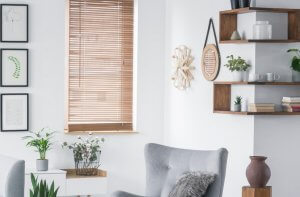
These are really useful for bathrooms and kitchens, allowing you to store small objects you want to keep close by.
Geometric shelves
As the name suggests, this final option involves using geometric shelves such as squares, hexagons or triangles. There are so many ways you can arrange them, depending on the amount of space you have to work with.

For example, hexagonal shelves could be arranged in a beehive pattern. Alternatively, you could use a combination of straight and geometric shelves. But remember, it’s always best to hang your shelves on a large wall so that your room doesn’t look cluttered.
As you can see, floating bookshelves are really versatile, allowing you to create a whole range of beautiful and practical arrangements. Plus, you can even design and make them yourself. If you’re looking for inspiration, you’ll find a number of fantastic video tutorials on YouTube – take a look!
In this article, we want to give you a step-by-step guide to decorating with floating bookshelves. Simple, quick and low-cost, you’ll have your shelves up in no time.
Most modern houses come with one huge downside – a lack of storage. So it’s important to try to make the most of every last inch of space, without your home looking cluttered.
When it comes to creating additional storage, floating shelves are a great option, as they don’t take up as much room as an ordinary bookshelf. Plus, you can place them at any height, so they’re a great way to make good use of empty wall space above low furniture, such as coffee tables and television stands.
While many stores will only offer the standard flat, rectangular shelf, there are a number of other options to choose from. You’ll also need to think about aspects such as thickness and color, as they will have a huge impact on the overall look.
In this next section, we’ll give you some ideas and advice for decorating with floating bookshelves. You’ll soon see just how practical and useful these shelves can be.
Create your own floating bookshelves – what you’ll need

The first step is to choose the material for your shelves. You’ll find a variety of wooden, glass and plastic (methacrylate or melamine) shelves in most home stores. For example, IKEA has a good range of shelves on offer.
If you decide to go for wooden shelves, you have the option of making them yourself, using pieces of scrap wood you have at home. It’s simply a question of attaching them together until you have the desired thickness.
If you do choose to buy them from a store, you’ll need to think about the style you want. For example, you can find shelves with square, round or beveled edges.
The only downside to buying your shelves in-store is that you may find you’re slightly limited in terms of the sizes and thicknesses on offer. However, if you’re into DIY, you could always customize your shelves at home.
Next, you’ll need to buy shelf brackets. You should be able to find these in most hardware and DIY stores. These are usually fairly cheap, and come in a range of different sizes and weight capacities, so it’s best to think about how much weight you want your shelves to support before you buy.
Finally, all you need to do is install them. Use a drill to make holes in both the shelf and your wall. If you don’t want to make holes in your wall, we recommend choosing hanging shelves instead. These will help you make the most of your space, without damaging your walls.
How to decorate with floating bookshelves

As we mentioned at the beginning of this article, there are so many ways you can decorate with floating shelves. They come in a range of materials and designs, each of which will help you create a different look.
The standard shelf
The standard rectangular shelf is the simplest and most popular. Some people prefer to have a single, long shelf running along one wall, often placing it parallel to the TV stand.
Other people like to have two or three shelves, placing them one above the other like a normal bookshelf. Because they are smaller, it’s important not to overload them, as exceeding the weight capacity could cause them to fall down.

Another option is to arrange your shelves along the length of one wall, placing them at different heights to create a really fun and dynamic look.
If you’re a fan of multicolored decor, you could choose a different color for each shelf. This is a really original idea that would work especially well in children’s bedrooms.
Floating corner shelves
Many of us struggle when it comes to making the most of corner spaces. Fortunately, we’re seeing more and more corner furniture on the market, including a fantastic range of floating corner shelves.
In this case, we recommend putting up several shelves one above the other, leaving enough space between each one to create a sense of order and balance. Start from the middle of the wall and work your way upwards. This will create a better overall effect, and ensure your shelves are at a convenient height.

These are really useful for bathrooms and kitchens, allowing you to store small objects you want to keep close by.
Geometric shelves
As the name suggests, this final option involves using geometric shelves such as squares, hexagons or triangles. There are so many ways you can arrange them, depending on the amount of space you have to work with.

For example, hexagonal shelves could be arranged in a beehive pattern. Alternatively, you could use a combination of straight and geometric shelves. But remember, it’s always best to hang your shelves on a large wall so that your room doesn’t look cluttered.
As you can see, floating bookshelves are really versatile, allowing you to create a whole range of beautiful and practical arrangements. Plus, you can even design and make them yourself. If you’re looking for inspiration, you’ll find a number of fantastic video tutorials on YouTube – take a look!







